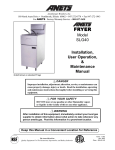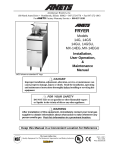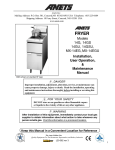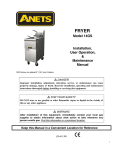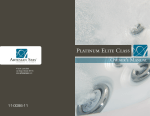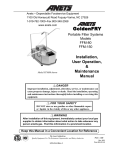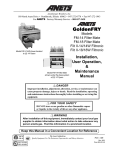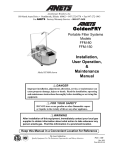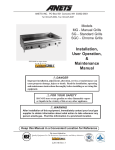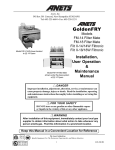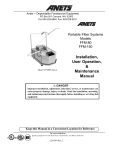Download Anets MX-14E Specifications
Transcript
Anetsberger Brothers, Inc. 180 North Anets Drive • Northbrook, Illinois 60062 • 847-272-0770 • Fax 847-272-1943 For ANETS Factory Warranty Service • 800-837-2638 FR YER FRYER Models MX-14E, MX-14-2E, MX-7E, MX-14AA, MX-14-2AA, MX-7A Installation, User Operation, & Maintenance Manual MX-14E shown with optional casters ! DANGER Improper installation, adjustment, alteration, service, or maintenance can cause property damage, injury or death. Read the installation, operating and maintenance instructions thoroughly before installing or servicing this equipment. ! FOR YOUR SAFETY DO NOT store or use gasoline or other flammable vapors or liquids in the vicinity of this or any other appliance. ! WARNING After installation of this equipment, immediately contact your local gas supplier to obtain information about what action to take whenever any person smells gas. Post this information in a prominent location. Keep this Manual in a Convenient Location for Reference The Anets GoldenLine Quality Equipment For The Restaurant, Supermarket, and Bakery Industries Form I-105; Rev. 10/01 Price $20.00 US 1 CONTENTS Shipping Container Inspection ....................................................... 3 Fryer Gas Supply Specifications .................................................... 4 Fryer Electrical Specifications ....................................................... 5 Figure 1 - Fryer MX-14E Wiring Diagram ............................ 5 Code Requirements ...................................................................... 6 Figure 2 - Fryer Site Installation Requirements ....................... 6 Installation Requirements ............................................................... 7 Installation Instructions .................................................................. 7 Leg Installation Instructions ..................................................... 7 Figure 3 - Typical Leg Installation ......................................... 8 Leg Leveling Instructions ......................................................... 8 Caster Installation Instructions ................................................. 8 Figure 4 - Typical Caster Installation ..................................... 9 Caster Leveling Instructions .................................................... 9 Fryer Restraining Device Installation Instructions ..................... 10 Gas & Electric Connection Instructions ....................................... 10 Fryer Operating Instructions ........................................................ 11 Fryer Preparation For Use (“Boil Out” Instructions) .............. 12 Figure 5 - Draining the Kettle ............................................... 12 Lighting Procedure ................................................................ 13 Figure 6 - Gas Control Valve & Knob Positions ................... 13 Shutdown Procedure ............................................................ 14 Food Product Frying Time Charts .................................... 15, 16 Daily Cleaning Procedure ....................................................... 17 Monthly Maintenance Instructions .......................................... 18 Fryer Troubleshooting Guide ................................................. 19 - 26 Fryer Warranty ............................................................................ 27 2 ! DANGER Read these specifications, Code Requirements, Installation Requirements, Installation Instructions, and Operating Instructions very carefully. Failure to follow the Instructions could cause the fryer to malfunction. A fryer malfunction can result in property damage, serious bodily injury, or death. SHIPPING CONT AINER INSPECTION CONTAINER 1. Carefully examine the shipping container for external damage. When damage is noted, notify the delivery carrier immediately. Save all packing materials for damage claim examination. 2. If no external damage is noted, remove the shipping container from the fryer and examine the fryer carefully for damage. Place the fryer in a safe location, if damage is noted, so that the freight damage claims adjuster can examine the fryer. 3. Save the shipping container for use during leg/ caster installation. Refer to the Installation Instructions for that procedure. Models Covered By This Manual MX-14E MX-14-2E MX-14-7E MX-14AA MX-14-2AA MX-7A High Efficiency Stainless Steel Fryer High Efficiency Stainless Steel Split Pot Fryer High Efficiency Stainless Steel Half Size Fryer High Efficiency Stainless Steel Fryer With Automatic Lifts High Efficiency Stainless Steel Split Pot Fryer With Automatic Lifts High Efficiency Stainless Steel Half Size Fryer With Automatic Lifts Standard Accessories furnished in the shipping carton with this fryer include: Models MX-14AA, -14-2AA, MX-14E, and MX-14-2E 2 Fryer Baskets 4 Adjustable Legs 1 Drain Valve Extension 1 Cleanout Rod 1 Screen 1 Basket Hanger* 2 Basket Lift Frames ** Models MX-7A and MX-7E 1 Fryer Basket 4 Adjustable Legs 1 Drain Valve Extension 1 Cleanout Rod 1 Screen 1 Basket Hanger* 1 Basket Lift Frame ** *- Basket Hanger for MX-14E, MX-14-2E, or MX-7E only. ** - Basket Lift Frame for MX-14AA, MX-14-2AA, or MX-7A only. NOTE: Other available optional equipment may include a sediment tray; a microprocessor-based cooking computer with shortening melter, boil-out mode, and digital timers (Fri-tronic®); a built-in filter system (Filtronic™ II or Filter Mate™); a fryer cover; a drain table; a front drain tray; or four casters. NOTE: A Parts List for each Anets Fryer is among the items shipped with each fryer. If an additional copy of this list is needed, please contact the factory as directed on the back cover. 3 FRYER GAS SUPPLY SPECIFICATIONS Please make sure that your desired fryer location has gas supply factors that are suitable for this product: Models MX-14E, MX-14-2E, MX-14AA, &MX-14-2AA INPUT REQUIRED: 111,000 BTU/Hr * MANIFOLD PRESSURE SUPPLY PRESSURE*** Natural Gas 3½“ W.C. ** 6“ W.C., minimum Propane Gas 10“ W.C. 11“ W.C., minimum Models MX-7E & MX-7A INPUT REQUIRED: 55,000 BTU/Hr * MANIFOLD PRESSURE SUPPLY PRESSURE*** Natural Gas 3½“ W.C. ** 6“ W.C., minimum Propane Gas 10“ W.C. 11“ W.C., mini- * - BTU/Hr Rating is based on sea level operation. For sites above 2000 feet, reduce this rating 4% for each 1000 feet above sea level. ** - “ W.C. = Inches, Water Column. *** - Measure Supply Pressure when all other gas-powered equipment is operating. Gas Supply Inlet Pipe must be ¾” NPT (National Pipe Thread) standard gas line. The gas supply inlet line should be as straight as possible (fewest bends or elbows) to obtain the highest available gas pressure at the appliance. Locate this inlet line horizontally at the center of the desired fryer location, approximately 8¼” above the floor. NOTE: Using a flexible inlet line permits variation in the gas supply line location, both horizontally and vertically. Anets fryers are only for use with the type of gas specified on the spec plate. If a fryer requires modification to use a gas other than that which is identified on the fryer spec plate, contact your Anets representative or call (800) 837-2638. 4 FRYER ELECTRICAL SPECIFICATIONS Please make sure that your desired fryer location has electrical supply factors that are suitable for this product: 120 Volts, 60 Hz, (Refer to Table 1 for amperage requirements), 1-phase, three-wire connection, including an electrical ground, via a dedicated circuit breaker. A model-specific electrical circuit diagram is mounted inside the front door of each fryer. Table 1. Fryer Amperage Requirements Model MX-14E MX-14-2E MX-7E MX-14AA MX-14-2AA MX-7A Amperage 2 A. 4 A. 2 A. 7 A. 9 A. 5 A. Install a dedicated, three-prong, outlet/ receptacle within 5 feet of the desired fryer location to allow the fryer’s power cable to be connected. Ensure that the green (ground) wire of the fryer’s power cable is attached to the fryer’s structure, providing an electrical ground in accordance with applicable local codes, or in the absence of local codes, with the National Electrical Code, ANSI/NFPA 70 (latest edition) or the Canadian Electrical Code, CSA C22.1 (latest edition) and CSA C22.2 (latest edition). ! WARNING Electrical Grounding Instructions (See inside of door for wiring diagram.) This appliance is equipped with a threeprong (grounding) plug for your protection against shock hazard, and should be plugged directly into a properly grounded, three-prong receptacle. DO NOT cut or remove the grounding prong from this plug. Figure 1 is the basic wiring diagram of an MX-series fryer showing a typical circuit. Some fryers may have other options that do not appear in this basic wiring diagram. A model-specific wiring diagram included with each fryer shows all the actual parts and their associated wiring connections. In addition, fryers equipped with a built-in filter system (Filtronic II or Filter Mate) and/or built-in computer controls (Fri-tronic) have a supplementary manual included for each option. Figure 1. Fryer Model MX-14E Wiring Diagram 5 CODE REQUIREMENTS IMPORTANT: Read the Code Requirements and the Installation Requirements and Iinstructions carefully, before starting the installation. Contact the factory (800/ 837-2638) if any problems or questions arise. The fryer installation must conform with local codes, or in the absence of local codes, with the National Fuel Gas Code, ANSI Z223.1 (latest edition); the Natural Gas Installation Code, CAN/ CGA-B149.1 (latest edition); or the Propane Gas Installation Code, CAN/CGA-B149.2 (latest edition), as applicable, including: a. Disconnect the fryer and its individual shutoff valve from the gas supply piping system during any pressure testing of the gas supply system at test pressures in excess of ½ psig (3.45 kPa). b. Isolate the fryer from the gas supply piping system during any pressure testing of the gas supply system at test pressures equal to or less than ½ psig (3.45 kPa). c. For fryers utilizing floor casters, the fryer installation shall be made with a connector that complies with the Standard for Connectors for Movable Gas Appliances, ANSI Z21.69 (latest edition) or CAN/CGA 6.16 (latest edition), and a quick-disconnect device that complies with the Standard for Quick-Disconnect Devices for Use with Gas Fuel, ANSI Z21.41 or CAN/CGA 1-6.9 (latest edition). From the top of the flue on the fryer, allow a minimum of at least 10 inches vertical clearance beneath a ventilating hood. Figure 2. Fryer Site Installation Requirements 6 d. Restrict the movement of a caster-equipped fryer by using a limiting device (for example, a cable attached both to the fryer and to a fixture attached to the site structure) to avoid depending on the connector and the quickdisconnect device or its associated piping to limit fryer movement. e. Install this fryer on a non-combustible floor with its back and sides at least 6” away from any combustible wall, as shown in Figure 2. ! WARNING Install this fryer under a ventilation hood that conducts combustion products outside the building. Venting must comply with ANSI/NFPA 96 (latest edition). f. Install this fryer in a location where adequate combustion and ventilation air is available. Keep the area directly in front of the fryer open for adequate air flow to the burners. DO NOT obstruct the flow of combustion and ventilation air. g. Keep the fryer area free and clear from combustibles and debris. h. Attach a restraining device to each fryer, to prevent the unit from tipping, which could cause splashing of hot liquid . INST ALLA TION REQ UIREMENTS INSTALLA ALLATION REQUIREMENTS Install the fryer in accordance with the preceding Code Requirements, as well as the following Installation Requirements. 1. DO NOT install this fryer in a mobile home, trailer, or recreational vehicle. 2. Install this fryer in a location that has the fryer’s electrical receptacle nearby (5 feet or less away) to avoid straining the fryer’s power cord. (See Figure 2.) 3. Install this fryer in a location that allows it to be moved away from other adjacent appliances for cleaning and maintenance. NOTE: If the fryer is installed among a row of appliances (“banked”), with its only convenient movement forward, sufficient room must be available in front of the fryer to permit its separation from adjacent appliances for cleaning and maintenance. 4. Tightly fasten the legs (or casters) to the bottom of the fryer using the supplied hardware, to prevent the fryer from tipping, wobbling or rocking when it is in its desired location. Refer to the following Leg Installation Instructions or Caster Installation Instructions for leg or caster attachment and leveling information. UTION: Hood make-up air CAUTION: ! CA MUST NOT flow in a manner that restricts or impedes the natural flow of combustion or ventilation air. 5. Confirm that the air from the ventilation hood flowing near the fryer after installation is NOT blowing on the rear of the unit, to prevent affecting the burner flames and possibly causing damage to plastic parts. INST ALLA TION INSTR UCTIONS INSTALLA ALLATION INSTRUCTIONS LEG INSTALLATION INSTRUCTIONS 1. Flatten the shipping carton (after unpacking the fryer and its parts and accessories) for fryer surface protection during leg installation. 2. Position the side of the fryer flat on the carton, exposing the fryer bottom mounting brackets for leg installation, as shown in Figure 3. 3. Place the leg mounting plate flush against the mounting bracket on the fryer bottom, while aligning the mounting holes. 5. Screw a locking nut several turns onto the mounting bolt. 6. Repeat steps 4 and 5 until all four mounting bolts for a leg are in place with locking nuts. 7. Tighten the four locking nuts evenly and securely to hold the leg mounting plate against the fryer bottom mounting bracket. 4. Insert one mounting bolt through a flat washer and then through the proper hole in the fryer mounting bracket and through the leg mounting plate. 7 INST ALLA TION INSTR UCTIONS INSTALLA ALLATION INSTRUCTIONS (Continued) Figure 3. Typical Leg Installation LEG LEVELING INSTRUCTIONS 1. Move the fryer to its desired location. ! WARNING The fryer MUST NOT tip, rock or wobble, to avoid splashing or spilling its HOT shortening contents during operation. 2. Turn the screw-type leg adjustment ends as necessary to level the fryer, until NO tipping, rocking, or wobbling is evident. 3. Perform the Fryer Restraining Device Installation Instructions, referring to Figure 2. CASTER INSTALLATION INSTRUCTIONS 1. Flatten the shipping carton (after unpacking the fryer and its parts and accessories) for surface protection during caster installation. 2. Position the side of the fryer flat on the carton, exposing the fryer bottom mounting brackets for caster installation, as shown in Figure 4. 3. Mount locking casters on the front of the fryer and fixed casters on the rear, by placing each caster mounting plate flush against the mounting bracket on the fryer bottom. 4. Insert one mounting bolt through a flatwasher 8 (supplied) and the mounting bracket, then through the caster mounting plate. 5. Screw a locking nut several turns onto the mounting bolt. 6. Repeat steps 4 and 5 until all four mounting bolts for a caster are in place with locking nuts. 7. Tighten the four bolts evenly and securely to hold the caster mounting plate against the fryer mounting bracket. INST ALLA TION INSTR UCTIONS INSTALLA ALLATION INSTRUCTIONS (Continued) Figure 4. Typical Caster Installation CASTER LEVELING INSTRUCTIONS 1. Move the fryer to its desired location. 2. Determine whether the fryer tends to wobble or rock when in its desired location. If it does, perform steps 3 through 9. If it does not, skip to step 10, then proceed to the Installation Instructions. ! WARNING The fryer MUST NOT tip, rock or wobble, to avoid splashing or spilling its HOT shortening contents during operation. 3. Determine which caster requires adjustment and the approximate amount of change required to level the fryer. 4. Position the side of the fryer on the shipping carton, exposing the bottom of the fryer with the caster mounting plates (Figure 4). 5. Completely unscrew the bolts holding the caster mounting plate that requires the leveling adjustment. Retain the locking nuts for later reassembly. CASTER LEVELING INSTRUCTIONS (Continued) 6. Reinsert each bolt through its flatwasher and the fryer mounting bracket; next, place a spacer of the required size on the bolt before inserting the bolt through its mounting hole on the caster mounting plate and screwing a locking nut onto the bolt. 7. Repeat step 6 for all remaining bolts. 8. Tighten all four locking nuts evenly and securely against the caster mounting plate and the fryer bottom mounting bracket. 9. Return the fryer to its desired location. Lock the front casters to prevent fryer movement and check again for wobbling or rocking. Repeat steps 3 through 9 until no wobbling or rocking occurs. When the fryer no longer wobbles or rocks, perform step 10. 10. Perform the Fryer Restraining Device Installation Instructions, referring to Figure 2. 9 INST ALLA TION INSTR UCTIONS INSTALLA ALLATION INSTRUCTIONS (Continued) FRYER RESTRAINING DEVICE INSTALLATION INSTRUCTIONS ! WARNING Fryers MUST have a movementlimiting (restraining cable) device installed to prevent tipping that causes splashing or spilling its HOT contents. NOTE: This movement-limiting device is to be furnished and installed by the fryer’s installing contractor before the fryer is connected to the gas line at its desired location. 1. Install one restraining device connector into the structure wall directly behind the fryer’s desired location, as shown in Figure 2. 2. Install one restraining device connector on the rear panel of the fryer very close to the quickdisconnect device on the end of the fryer’s gas line. NOTE: Avoid interfering with the lift mechanism, on AA models. 3. Attach one end of the restraining cable to the wall connector. Attach the other end to the fryer connector. 4. Confirm that the fryer cannot move far enough away from the wall to cause excessive movement of the flexible gas line or its associated connectors. GAS & ELECTRIC CONNECTION INSTRUCTIONS Installing your ANETS Fryer requires the following procedure, after its legs or casters are properly attached and it is in its desired location. 1. Ensure that the gas control valve knob in the fryer has its OFF position next to the valve mark. 10 ! WARNING DO NOT use a flame to check for leaks. 2. Ensure that the gas supply inlet line valve is closed (handle crosswise to the line direction). 5. Open the gas supply line valve (handle in-line with line direction); then, confirm that all gas supply line joints and couplings are free of leaks using soap suds or a leak-check solution, after the fryer is in its desired location. 3. Ensure that the circuit breaker dedicated to this fryer is OFF and that all fryer controls are set to OFF. 6. Plug the fryer’s electric power cord plug into the receptacle specified for this fryer. Switch the circuit breaker to ON. 4. Connect the ¾” gas supply line to the gas line adapter on the lower rear of the fryer. 7. Refer to Fryer Operating Instructions to begin using your ANETS Fryer. FR YER OPERA TING INSTR UCTIONS FRYER OPERATING INSTRUCTIONS ! CAUTION DO NOT operate this fryer during a power outage or interruption of gas service. Turn all fryer controls to OFF, including the gas control valve knob, then close the gas supply line valve. Also, switch off the circuit breaker controlling electric power to the fryer. When notified that the power outage has ended, perform the Lighting Procedure (later in this manual). ! DANGER NEVER operate this fryer when its flue is blocked or when the ventilation hood is not on because the combustion products can accumulate and cause serious injury or death. ! DANGER Avoid moving the fryer while it contains HOT shortening. Drain the shortening from the fryer before moving it for service, cleaning, or maintenance to avoid spilling or splashing. Burns from hot shortening can cause serious injury or death. A. An ANETS MX-14E or MX-14AA Fryer is designed for operation with a kettle filled with approximately 35 to 50 pounds of liquid shortening. (This is approximately 3½ to 6 gallons.) Each kettle of an ANETS MX-14-2AA, MX-14-2E, MX-7A, or MX-7E Fryer is designed for operation with approximately 25 pounds of liquid shortening. (This is approximately 2½ to 3 gallons.) ! CAUTION: Unless this fryer is equipped with the controls permitting the melting of shortening*, DO NOT melt solid shortening in this fryer because the melting can damage the kettle, which will void the fryer warranty. * Fryers that are shipped with multiproduct cooking computers (Fritronic ) have an automatic ‘Melt’ selection to liquefy solid shortening. Shortening must be melted into the liquid state before it can be used in an ANETS Fryer, unless the fryer has an automated ‘melt’ selection available on its control panel. B. Schedule regular cleanings of the fryer to ensure long-term satisfactory operation. Refer to the Daily Cleaning Procedure, later in this manual. C. Before servicing and maintenance, allow the fryer to cool. ALWAYS shut off electricity and gas to the fryer while working on it, to prevent electric shocks or burns. D. Contact the factory (800-837-2638) for warranty service authorization. [Always notify the factory the next business day about ‘after-hours’ warranty service.] Contact your local restaurant equipment service agency for other service, repairs, or maintenance activities, as necessary. E. When breaded food products are being cooked, ANETS recommends using the special (optional) sediment tray to capture any breading fragments that become loosened from the food product. Periodic clearing of the sediment tray reduces premature contamination of the liquid shortening from breading fragments. 11 FR YER OPERA TING INSTR UCTIONS FRYER OPERATING INSTRUCTIONS FRYER PREPARATION FOR USE “BOIL OUT” INSTRUCTIONS New ANETS Fryers are cleaned and leak-tested at the factory before shipping. Before using a newly installed fryer for food preparation, clean the kettle again, as follows: 1. Thoroughly wipe the interior of the kettle with clean cloths. Open the front door on the lower portion of the fryer to access the drain ball valve. Open the drain ball valve (by aligning the valve handle with the drain ball valve) and wipe the entire drain line clean. 2. Close the drain ball valve (turn the valve handle cross-wise to the drain ball valve). Fill the kettle with water to about 3“ from the top. Add 1 to 2 cups of low sudsing soap powder, washing soda (trisodium phosphate), or deep fat fryer kettle cleaner. (Continued) FRYER PREPARATION FOR USE (Continued) ! CAUTION For a fryer with a built-in filter system, DO NOT pump the cleaning (or rinsing) solution through the filter system, to avoid damaging the filter system pump. 7. Open the front door and mount the drain extension to the drain ball valve. Position a container (bucket) capable of holding HOT cleaning solution beneath the end of the drain extension to hold the cleaning solution being drained, as shown in Figure 5. 3. Perform the Lighting Procedure for the fryer. (Refer to the Lighting Procedure later in this manual.) 4. Set the thermostat to 190°F. Heat, but DO NOT boil the water. Stir the water to dissolve the cleaning material. ! WARNING Hot cleaning solution can cause severe burns. Take care when handling hot cleaning solution to avoid spilling or splashing the solution. 5. Clean the fryer kettle for at least 20 minutes. Use a small hand mop (an optional brush can be ordered for this purpose) to clean the upper portion of the kettle (above the 3“ waterline) and the top rim of the kettle. 6. Shut down the fryer using the Shutdown Procedure for the fryer. Refer to the Shutdown Procedure later in this manual. For safety, allow the water to cool (below 140ºF) before draining. Figure 5. Draining The Kettle 8. Open the drain ball valve SLOWLY, to avoid splashes while draining the cleaning solution from the kettle. 9. Close the drain ball valve (valve handle cross-wise) and remove the drain extension. Close the front door. 10. Safely dispose of the cleaning solution. 11. Fill the kettle with water to about 3“ from the top. Add 2 cups of vinegar to neutralize the cleaning solution. 12. Repeat steps 3 through 10 of this procedure. 13. Thoroughly wipe the interior of the kettle and the drain ball valve with clean, dry, wiping cloths to remove ALL water. 14. Dry the kettle thoroughly because any remaining water can cause spattering of hot shortening when the kettle is later filled and heated. 12 FR YER OPERA TING INSTR UCTIONS FRYER OPERATING INSTRUCTIONS (Continued) Normal operation of an ANETS Fryer requires that the kettle is filled with liquid shortening above the lower indent level, marked on the rear of the kettle, before lighting the fryer’s pilot and turning on the main burner. ! CAUTION: Shortening MUST be in liquid form to avoid scorching or discoloration and possible damage to the kettle. Damage caused by melting solid shortening will NOT be covered by the warranty. LIGHTING PROCEDURE NOTE: The gas line of a new fryer installation may contain a considerable amount of air which will hinder immediate lighting. You may have to press down the control knob for as long as several minutes until the pilot flame burns steadily. 1. Switch the circuit breaker controlling electric power to the fryer to ON. 2. Ensure that the fryer’s thermostat knob is set to OFF. 3. Open the gas supply line inlet valve to the fryer by aligning the gas valve handle with the gas line piping. 4. Open the front door and move the right pilot viewing/lighting port cover aside. ! CAUTION: Ensure that both pilot viewing/lighting ports are closed, to prevent excessive heat from damaging the gas controls. 9. Turn the gas control valve knob to align the ON setting with the valve mark. 10. Close the front door and switch the fryer POWER switch ON. NOTE: A fryer equipped with built-in filtering system (Filtronic or Filter Mate) requires the front door to be closed before switching the POWER switch to ON. 11. Turn the thermostat knob to the desired temperature. 5. Turn the gas control valve knob to align the PILOT setting with the valve mark. Figure 6 shows the possible control knob positions. 6. Press, and hold down, the gas control knob to allow pilot gas to flow. Push the spark igniter pushbutton several times, until the pilot flame lights. Continue holding down the control knob for at least 30 seconds until the pilot flame burns steadily, without going out. NOTE: A match may also be used to light the pilot flame. ON T ON OFF OFF F PILOT T OFF PI PI L O PI T LO LO Valve Mark OF 8. Light the left pilot flame by opening the left pilot viewing/lighting port and applying a match to ignite the pilot flame. Close the left pilot viewing/lighting port. Valve Mark Valve Mark ON 7. Release the control knob and observe that the pilot flame remains lighted. Close the right pilot viewing/lighting port. ON Figure 6. Gas Control Valve & Knob Positions 13 FR YER OPERA TING INSTR UCTIONS FRYER OPERATING INSTRUCTIONS (Continued) SHUTDOWN PROCEDURE NOTE: Shutdown is recommended at the end of a workday or whenever no frying is required for a period of several hours. The fryer MUST be shutdown during any power outage or interruption of gas service. To prevent damage, the fryer MUST also be shutdown whenever there is no shortening in the kettle. 14 1. Turn the thermostat knob to OFF. 2. Turn the gas control valve knob to align the PILOT setting with the valve mark. 3. Open the pilot viewing/lighting port to confirm that only the pilot flame remains lighted. 4. Press, and turn, the gas control valve knob to align the OFF setting with the valve mark. Observe that the pilot flame goes out. 5. Switch the POWER switch to OFF. NOTE: For extended periods of non-use or when servicing the fryer, close the gas supply line inlet valve to the fryer by turning the gas valve handle cross-wise with the gas line piping. Also, switch the circuit breaker for this fryer to the OFF position. FR YER OPERA TING INSTR UCTIONS FRYER OPERATING INSTRUCTIONS (Continued) Load the fryer basket with the food product while the basket is not in the hot liquid shortening. DO NOT overload the fryer basket. Load only a premeasured quantity of food product (1½ lb per basket, or less, if smaller portions are desired). ` Model MX-14AA and MX-7A Fryers ONLY: Place the loaded fryer basket on the basket lifter frame and turn the timer control knob to the desired cooking time; press the pushbutton of the timer control to lower the loaded basket into the hot liquid shortening. When the basket of cooked food product rises from the hot liquid shortening, let it drain for approximately 15 - 30 seconds before serving. Fryers equipped with multi-product cooking computers: Consult the instructions provided with those fryers. NEVER increase the thermostat setting above the recommended setting to reduce the cooking time; this will produce a lower quality product and will cause more rapid shortening breakdown. RECOMMENDED FRYING TIME FOR POTATOES French Fries ANETS High Performance Fryer Size (Typical, 1½ lb loads) 340° F. Frying Time (minutes) 5 2½ 2½ Raw to Done Blanched, only Browned, only 1/4” cut 1/4” cut 1/4” cut Raw to Done Blanched, only Browned, only 3/8” cut 3/8” cut 3/8” cut 6 3 3 Commercially Treated Frozen, Fat Blanched 3/8” cut 3/8” cut 6 2 Raw to Done Blanched, only Browned, only 1/2” cut 1/2” cut 1/2” cut 7 4 3 340° F. RECOMMENDED FRYING TIME FOR CHICKEN (Depending on Piece Size) Chicken Croquettes (Nuggets) Pre-cooked, Breaded Pieces Raw to Done, Pieces* Tenders ANETS High Performance Fryer 340° F. 340° F. Frying Time (minutes) 3-4 3-4 12 - 15 5 * - Usual per order = Wing, Leg, Breast, Thigh (1/2 chicken) 15 FR YER OPERA TING INSTR UCTIONS FRYER OPERATING INSTRUCTIONS (Continued) RECOMMENDED FRYING TIME FOR POPULAR FRIED FOODS Food Product Breaded Foods Calamari Cauliflower, Pre-cooked Cheese Sticks Clams Egg Plant, Pre-cooked Mushrooms Oysters Onion Rings Tamale Sticks Veal Cutlet ANETS High Performance Fryer 340° F. Frying Time (minutes) 2½ - 3 3 3 1 3 2½ - 3 5 2½ - 3 3 3-4 3-4 Calzone (Pizza Puffs) 3½ - 4 Corn-on-the-Cob (Fresh) Corn Dogs 3½ Donuts, Hand-Cut, Cake Donuts, Yeast, Raised 1½ 1 Fritters 3 French-toasted Sandwiches 1 Frozen Breaded Shrimp Fresh Breaded Shrimp 4 3 5-7 3 Frozen Fish Fillets Fresh Fish Fillets Fresh Breaded Scallops 4 Frozen Fish Sticks 4 3-5 Glazed Cinnamon Apples 2 - 2½ Tortilla Chips* Turnovers 340° F. 5-7 * - Use a second basket on top of the chips in the bottom basket, to keep them within the hot shortening; otherwise, they float before cooking completely. 16 FR YER OPERA TING INSTR UCTIONS FRYER OPERATING INSTRUCTIONS (Continued) DAILY CLEANING PROCEDURE DAILY CLEANING PROCEDURE NOTE: Cleaning is recommended at the end of a workday, to prepare the fryer for proper operation the next time it is to be used. (Continued) 5. Allow shortening to cool before draining. Slowly open the drain ball valve to drain the shortening. Take care to avoid spilling or splashing the shortening. ! DANGER DO NOT move the fryer while it contains HOT shortening. Allow it to cool and drain the shortening from the fryer before moving it for service, cleaning or maintenance to avoid spilling or splashing. [Refer to steps 1 through 7.] Burns from HOT shortening can cause serious injury or death. When cleaning, if relocation of your fryer is necessary, disconnect the gas supply line and unplug the electric power cable to the fryer. Also, if your fryer is caster-equipped, unlock the locking casters and disconnect the movement-limiting cable. Move the fryer as necessary to allow the following cleaning procedure to occur: 1. Open the front door of the fryer. Attach the drain extension to the drain ball valve. 2. Perform the Shutdown Procedure. Ensure that the gas supply line inlet valve is closed (handle cross-wise to pipe line) and the pilot flame is extinguished. 3. Position a steel drum [NEVER use plastic!] with a filter cone directly beneath the drain extension end, OR if your fryer is equipped with an ANETS Filtronic II or Filter Mate unit, refer to that equipment’s manual for operation details. 4. Remove the fryer baskets and the sediment tray, if present, from the fryer. (If the screen is present, use the cleanout rod to lift it from the hot shortening, to avoid burns.) Clean, and rinse, these items in the sink. MAKE SURE that these items are completely dry before their next use. 6. Carefully use the Cleanout Rod to clear any sediment blocking the kettle drain. Flush out all sediment in the bottom of the kettle by pouring filtered liquid shortening into the kettle until the shortening being drained runs clear. 7. Close the drain ball valve, after the kettle is completely empty of shortening and sediment. Detach the drain extension. Clean, rinse, and dry it before storing (on door bracket). ! WARNING Wait until the kettle has cooled before performing step 8, to avoid injury from burns. 8. Thoroughly wipe the kettle interior using clean cloths. 9. Periodically perform the “BOIL OUT” Instructions to ensure thorough cleaning of the kettle. ( Refer to the earlier FRYER PREPARATION FOR USE section.) 10. Return the fryer to its normal operating location and reconnect both the gas supply line and the movement-limiting cable. Plug the electric power cable into its receptacle. (For caster-equipped fryers, lock the locking casters to prevent movement.) 11. Refill the kettle with filtered (or fresh) liquid shortening to the desired indent mark on the rear wall of the kettle, only if fryer operation is to continue during a subsequent shift. Otherwise, melt shortening into its liquid state and refill the kettle before fryer operation is 17 FR YER OPERA TING INSTR UCTIONS FRYER OPERATING INSTRUCTIONS (Continued) DAILY CLEANING PROCEDURE (Continued) scheduled during the next normal working shift. 12. Return the screen (or, if used, the sediment tray) to its proper position in the kettle. Place the fryer baskets on the basket hanger (or the lifter frame) for this fryer. 13. Perform the Lighting Procedure to return the fryer to operation, when desired. MONTHLY MAINTENANCE INSTRUCTIONS NOTE: Regular maintenance is recommended to keep the fryer operating properly. Once each month, before beginning fryer operation, check the flue (behind the backsplash panel) to ensure that it is clear and free of obstructions, enabling exhaust combustion gases to flow freely toward the ventilation hood area. DO NOT allow the flue to become excessively dirty, NEVER allow the flue to be blocked. 18 Monthly, observe the condition of the ventilation hood. If it shows evidence of a great deal of greasy residue, remove (clean) the residue to allow free flow of ventilation air. FR YER TR OUBLESHOO TING GUIDE FRYER TROUBLESHOO OUBLESHOOTING All service (repairs or part replacement) must be performed by a qualified Service Agency. PROBLEM CAUSE Pilot (piezo-electric) 1. Electrode of igniter out of position or pushbutton igniter does dirty/sooty electrode. not light the pilot flame. Pilot flame does not stay lighted. REMEDY 1. Move electrode within 3/16” of pilot burner tip. Clean the electrode. 2. Loose spark wire; loose igniter nut. 2. Check spark wire connection at the igniter nut and make sure the connection is tight. 3. Piezo-electric igniter does not generate a spark. 3. Replace igniter mechanism (portion with pushbutton). 1. Dirty/sooty pilot burner. 1. Clean the pilot burner. Perform the Lighting Procedure. 2. Low gas supply pressure [less than 6” W.C. for natural gas; (11” W.C. for propane) when all other gas-powered equipment is operating]. 2. Measure the gas supply pressure. Contact your local gas supplier to obtain adequate gas supply pressure. 3. Pilot flame too small to heat thermocouple. 3. Adjust the pilot valve (part of the gas control valve) to increase the flame size: Unscrew and retain the slotted threaded cover; turn the pilot valve adjustment screw two turns counterclockwise; reinstall the threaded cover. 4. Pilot flame ‘wavering’ (being blown about by a draft). 4. Block or redirect the draft, to keep the flame burning steadily. 5. Improper thermocouple output voltage (must be at least 10 millivolts, measured at the thermocouple junction block). 5. Replace the thermocouple. 6. High-limit thermostat problem has shut off the gas. 6. Check for, and repair, any damaged high-limit thermostat wiring. Test the high-limit thermostat by disconnecting the thermocouple at the gas control valve. Also, disconnect the red wires to the high-limit thermostat from the gas control valve. Reconnect the thermocouple; then, perform the Lighting Procedure, to check whether the pilot flame lights. If the pilot 19 FR YER TR OUBLESHOO TING GUIDE FRYER TROUBLESHOO OUBLESHOOTING PROBLEM CAUSE Pilot flame does not 6. High-limit thermostat problem has shut off stay lighted. (Continued) the gas. (Continued) (Continued) REMEDY 6. (Continued) flame stays lit, the high-limit thermostat has failed and must be replaced. ! CAUTION: DO NOT return the fryer to normal operation with its high-limit thermostat bypassed/disconnected. Pilot flame goes out repeatedly. 7. Gas control valve has failed. 7. Replace the gas control valve. 1. Low gas supply pressure [less than 6” W.C. for natural gas; (11” W.C. for propane) when all other gas-powered kitchen equipment is operating]. 1. Measure the gas supply pressure. Contact your local gas supplier to obtain adequate gas supply pressure. 2. Loose thermocouple or high-limit thermostat connection(s) on gas control valve. 2. Check and tighten the connections. 3. Pilot flame does not continuously touch the thermocouple because of excessive air flow around the pilot burner assembly. 3. Block the excessive air flow to make the pilot flame contact the thermocouple. 4. High-limit thermostat problem has shut off the gas. 4. Check for, and repair, any damaged high-limit thermostat wiring. Test the high-limit thermostat by disconnecting the thermocouple at the gas control valve. Also, disconnect the red wires to the high-limit thermostat from the gas control valve. Reconnect the thermocouple; then, perform the Lighting Procedure, to check whether the pilot flame lights. If the pilot flame stays lit, the high-limit thermostat has failed and must be replaced. ! CAUTION: DO NOT return the fryer to normal operation with its high-limit thermostat bypassed/disconnected. Main burners do not ignite. 20 1. Electric power circuit breaker not switched ON. 1. Switch the circuit breaker ON. 2. Electric power cord not plugged into its receptacle. 2. Plug in the power cord. FR YER TR OUBLESHOO TING GUIDE FRYER TROUBLESHOO OUBLESHOOTING PROBLEM Main burners do not ignite. (Continued) CAUSE REMEDY 3. POWER switch of fryer not switched ON. 3. Press the POWER switch ON. 4. Gas control valve knob set to OFF or PILOT. 4. Perform the normal Lighting Procedure. Turn the gas control valveknob to ON to light the main burners. If the burners do not light, the gas control valve has failed and must be replaced. 5. Front door open, causing the door microswitch to actuate. 5. Close the door; then switch the POWER switch OFF and back to ON. (This resets the gas control valve for proper operation.) NOTE: This only applies to a fryer with a built-in filter system. Main burners do not stop burning. (Continued) 6. Low gas supply pressure [less than 6” W.C. for natural gas; (11” W.C. for propane) when all other gas-powered equipment is operating]. 6. Measure the gas supply pressure. Contact your local gas supplier to obtain adequate gas supply pressure. 7. Pilot burner problem. 7. Refer to the preceding Pilot Burner problems and use the correct remedy. 8. Thermostat control set below the temperature of the liquid shortening in the kettle. 8. Increase the thermostat setting until the burners light. If this setting is greater than the desired temperature, reset the thermostat to the desired setting and allow the shortening to cool to the desired temperature. 9. Gas control valve has failed. 9. Replace the gas control valve. 1. Thermostat has failed. 1. Turn the thermostat control knob to OFF. If the burners do not quit burning, the thermostat has failed and must be replaced. 2. Gas control valve has failed. 2. Turn the gas control valve knob to OFF. If the burners do not quit burning, the gas control valve has failed and must be replaced. 21 FR YER TR OUBLESHOO TING GUIDE FRYER TROUBLESHOO OUBLESHOOTING PROBLEM CAUSE (Continued) REMEDY Liquid shortening does 1. Low gas supply pressure [less than 6” W.C. 1. Measure the gas supply presnot reach the desired for natural gas; (11” W.C. for propane) sure. temperature for frying. when all other gas-powered equipment is Contact your local gas supplier to obtain adequate gas supply operating], causing reduced heat from main pressure. burners. 2. Low gas manifold pressure [less than 3½” W.C. for natural gas; (10” W.C. for propane)]. 2. Measure the gas pressure at the fryer’s manifold pressure tap. Adjust the manifold pressure (see Figure 6), as necessary: [a] Unscrew (and retain) the threaded Main Burner Regulator Adjustment Cover. Use a flat-blade screwdriver to turn the regulator adjustment screw (clockwise to increase; counterclockwise to decrease) to reset the pressure adjustment. Reinstall, and tighten, the Regulator Adjustment Cover, when finished. 3. Stir the shortening to mix the 3. Loose knob on thermostat; or thermostat hot shortening with some from requires calibration (temperature setting difthe lower ‘cool zone’ and allow fers by about 10°F from measured shortenit to sit for 5 minutes. Turn the ing temperature). thermostat knob until it ‘clicks’ on (causing the main burners to flame); note the setting where this occurs. Turn the thermostat until it ‘clicks’ off (causing the main burners to go out); note the setting where this occurs. Repeat this temperature ‘click points’ step at least three times to ensure that the shortening temperature has stabilized. Measure the temperature of the shortening by inserting an accurate thermometer about 4 inches into the shortening to measure its temperature. If the temperature variation between the measured temperature and the thermostat setting is 10°F or less, the thermostat can be recalibrated. 22 FR YER TR OUBLESHOO TING GUIDE FRYER TROUBLESHOO OUBLESHOOTING PROBLEM CAUSE (Continued) REMEDY 3. (Continued) Liquid shortening does 3. Loose knob on thermostat; or thermostat Recalibrate the thermostat by: not reach the desired requires calibration (temperature setting dif(a) removing the cap on the temperature for frying. fers by about 10°F from measured shortenthermostat control knob; (b) (Continued) ing temperature). (Continued) loosening the center brass hex nut portion of the knob; (c) turn the pointer portion of the knob to the measured temperature value of the thermostat settings. Tighten the brass hex nut to lock the adjustment. Replace the cap on the knob. 4. Thermostat setting is more than 20°F different than measured shortening temperature. Basket does not lower, 1. Electric power circuit breaker not when the timer control switched ON. pushbutton is pressed after the timer control 2. Electric power cord not plugged into its receptacle. knob is set to a time value. 3. POWER Switch not switched ON. 4. Check the thermostat setting against an accurate measure of the shortening temperature. If the temperature difference is greater than 20°F, the thermostat can possibly be recalibrated. Recalibrate the thermostat by: (a) removing the cap on the thermostat control knob; (b) loosening the center brass hex nut portion of the knob; (c) turn the pointer portion of the knob to the measured temperature. Tighten the brass hex nut to lock the adjustment. Replace the cap on the knob. If this calibration is unsuccessful, the thermostat has failed and must be replaced. 1. Switch the circuit breaker to ON. 2. Plug in the power cord. 3. Switch the POWER switch ON. 4. Loosened wiring connections. 4. Check wiring and tighten all connections, especially to the basket lifting devices (timer, microswitch, and motor). 5. Timer has failed. 5. Set a time value using the timer control knob; press the push23 FR YER TR OUBLESHOO TING GUIDE FRYER TROUBLESHOO OUBLESHOOTING PROBLEM Basket does not lower, when the timer control pushbutton is pressed after the timer control knob is set to a time value. (Continued) Basket does not raise, after the timer control knob reaches a timer value of 0 (zero). 24 CAUSE (Continued) REMEDY 5. Timer has failed. (Continued) 5. (Continued) button to start the timer operation. If the basket does not lower into the kettle, the timer has failed and must be replaced. To confirm that the timer is defective, connect a wire as a short circuit between the wire terminals marked “C” (white wire) and “NO” (left motor: blue wire; right motor: brown wire) on the respective timer. If the lift motor now operates to lower the basket, the timer has failed and must be replaced. If the lift motor still does not operate, the microswitch or the motor may have failed. Refer to Cause 6 of this problem. 6. Microswitch (controlling the lift motor) has failed. 6. Set a time value using the timer control knob; press the pushbutton to start the timer operation. Check for 120-volt power by measuring between the “C” terminal (white wire) and the “NO” terminal (left motor: black wire; right motor: brown wire) of the microswitch. If no 120-volt power is present between these respective terminals, the microswitch is defective and must be replaced. If 120-volt power is present, but the motor still does not operate, the motor has failed and must be replaced. 1. Lifting mechanism or motor has failed. 1. If the motor operates, but the basket doesn’t raise, observe whether the motor crank assembly moves. If the motor crank assembly does not move, yet the motor shaft is turning, the shear pin in the motor shaft is broken and must be replaced. FR YER TR OUBLESHOO TING GUIDE FRYER TROUBLESHOO OUBLESHOOTING PROBLEM Basket does not raise, after the timer control knob reaches a timer value of 0 (zero). CAUSE 1. Lifting mechanism or motor has failed. (Continued) (Continued) REMEDY 1. (Continued) If the motor operates, but the motor shaft is not turning, the gear inside the lift motor has failed and the lift motor must be replaced. If the motor does not operate, check for 120-volt power between the motor’s terminals. If 120-volt power is present between the motor terminals, yet the motor does not operate, the motor has failed and must be replaced. If no 120-volt power is present between the motor terminals, the microswitch or timer has failed and must be replaced. Refer to the following “Causes” 2 and 3. Basket lowers and raises, repeatedly. 2. Microswitch has failed. 2. Check for 120-volt power by measuring between the “C” terminal (white wire) and the “NO” terminal (left motor: black wire; right motor: brown wire) of the microswitch. If 120-volt power is present between these respective terminals but the motor does not operate, the microswitch has failed and must be replaced. 3. Timer has failed. 3. If no 120-volt power is present between the microswitch terminals “C” and “NO”, the timer has failed and must be replaced. 1. Lifting mechanism microswitch is improperly positioned. 1. Position the microswitch properly. Basket raises, after the 1. Lift motor has failed. timer control knob reaches a timer value of 0 (zero), but then sinks back into the kettle. 1. Replace the lift motor. 25 FR YER TR OUBLESHOO TING GUIDE FRYER TROUBLESHOO OUBLESHOOTING PROBLEM HEATING indicator is off, while burners are aflame. CAUSE (Continued) REMEDY 1. HEATING indicator wiring problem. 1. Repair indicator wiring if a problem is detected. Otherwise, the indicator is defective and should be replaced. 2. Indicator has failed. 2. Replace the HEATING indicator. 1. POWER indicator wiring problem. Indicator portion of POWER switch is unlighted, while fryer is operating. 2. POWER indicator has failed. 1. Repair POWER switch/indicator wiring, if a problem is detected. Fryer does not begin to 1. Switch portion of POWER switch has operate when ON failed. portion of POWER switch is pressed. 1. Check switch wiring for problem; repair as necessary. If no wiring problem is detected, replace the faulty POWER switch/indicator as a unit. 2. Replace the POWER switch/ indicator as a unit. NOTE: A Parts List for each Anets Fryers is among the items shipped with each fryer. If an additional copy of this list is needed, please contact the factory as directed on the back cover. 26 LIMITED WARRANTY ANETSBERGER BROTHERS, INC., Northbrook, Illinois, USA, certifies that all equipment of its manufacture is, to the best of its knowledge, free from defective material and workmanship. ANETSBERGER BROTHERS, INC., agrees to replace any integral part of its equipment that proves defective within 15 months of date of original shipment from the factory, or 12 months from the date of installation, whichever is sooner. Buyer must return the defective part to the factory, freight prepaid, for inspection. Anetsberger Brothers, Inc., further agrees to assume the cost of installing said replacement part within the same period. All frypots are covered by the warranty above for the first year of operation. Various models have an extended warranty that cover the replacement of the frypot only. See the individual specification sheets for details. Overtime charges, calibration, adjustments and abnormal installation charges shall not be at the expense of Anetsberger Brothers, Inc. The conditions and warranty expressed above are valid only if equipment has been properly installed and operated. No other warranty, expressed or implied, shall govern equipment manufactured by Anetsberger Brothers, Inc. Under no circumstances shall Anetsberger Brothers, Inc., be liable for loss of profits or any direct or indirect cost, expenses, loss or damages arising out of defects in or failure of the equipment or any part thereof. 27 Anetsberger Brothers, Inc. 180 North Anets Drive • Northbrook, Illinois 60062 • 847-272-0770 • Fax 847-272-1943 Toll-free Customer & Warranty Service: 800/ 837-2638 Web Site: www.anetsberger.com Keep this Manual in a Convenient Location for Reference Form I-105; Rev. 10/01 Price $20.00 US 28




























